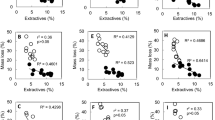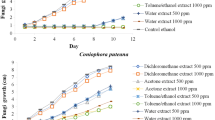Abstract
Knowledge on wood natural durability is required in order to be able to decide if we can use a certain type of wood outdoors. For instance, when used outside, oak wood is subjected to the leaching of its water-soluble substances. In this case the resistance of European oak wood is considered to be durable according to the European Standard EN 350-2. However, so far we do not exactly know the real impact of the leaching phenomenon on the resistance of oak wood and the importance of chemical contents. Nevertheless, our study has indicated that some individuals may contain highly durable wood characteristics even after the leaching process (i.e. 33% of very durable wood was still very durable after the leaching test). Chemical analysis has demonstrated that the presence of phenolic compounds are positively correlated with durability. This means that higher proportions of phenol confer higher resistance on wood. After the leaching test, which involves a washout of water soluble compounds, 70% of the trees demonstrate a decline in durability (after the leaching test 75% of the very durable wood dropped to a durable class; whereas, 25% of the wood in the same class still kept their very durable status). This experiment clearly shows the influence of the leaching phenomena and its important role on durability in oak wood. The results show also that 18% of the oak samples could be considered as very durable even after leaching.
Zusammenfassung
Kenntnisse über die natürliche Dauerhaftigkeit von Holz sind erforderlich, um entscheiden zu können, ob ein bestimmter Holztyp für Außenverwendung nutzbar ist. Z. B. wird europäische Eiche als dauerhaft angesehen gemäß dem europäischen Standard EN 350-2. Allerdings kennen wir bisher die tatsächliche Wirkung des Phänomens des Auslaugens auf die Widerstandsfähigkeit des Eichenholzes und die Wichtigkeit der chemischen Inhalte nicht. Unsere Studie hat jedoch ergeben, dass einige Exemplare hoch dauerhafte Holzcharakteristiken haben können sogar nach dem Auslaugeprozess (d. h. 33% des sehr haltbaren Holzes waren nach dem Auslaugetest immer noch sehr haltbar). Die chemische Analyse hat gezeigt, dass die Existenz von Phenolkomponenten positiv mit Dauerhaftigkeit verbunden waren. Das heißt, dass höhere Phenolanteile einen höheren Widerstand des Holzes bewirken. Nach dem Auslaugetest, der ein Auswaschen der wasserlöslichen Bestandteile beinhaltet, zeigen 70% der Bäume einen Rückgang der Dauerhaftigkeit (nach dem angewendeten Auslaugetest fielen 75% des sehr dauerhaften Holzes in eine dauerhafte Klasse; wobei 25% des Holzes in der gleichen Klasse seinen sehr dauerhaften Status immer noch behielt). Dieses Experiment zeigt klar den Einfluss des Phänomens des Auslaugens und seine wichtige Rolle für die Dauerhaftigkeit des Eichenholzes. Die Ergebnisse zeigen ebenfalls, dass 18% der Eichenproben sogar nach dem Auslaugen als sehr dauerhaft angesehen werden konnten.




Similar content being viewed by others
References
Van Acker J, Militz H, Stevens M (1999) The significance of accelerated laboratory testing methods determining the natural durability of wood. Holzforschung 53(5):449–458
Ayadi N, Charrier B, Irmouli M, Charpentier JP, Jay Allemand C, Feuillat F, Keller R (2001) Interspecific variability of European oak durability against white rot fungi (Coriolus versicolor): comparison between sessile oak and peduncle oak (Quercus petraea and Quercus robur). Proceedings of the 32nd International Conference of IRG. 20–25 mai. Nara. Japon. 7 pp
Bailleres H, Thevenon MF, Lanvin JD, Langbour P (2002) Développement d’une méthode spectroscopique non destructive d’évaluation de la durabilité naturelle du bois. Rapport d’avancement ADEME Bois Matériau. Cirad-Forêt
Becker L, Matuschek G, Lenoir D, Kettrup A (2001) Leaching behaviour of wood treated with creosote. Chemosphere 42(3):301–308
Cadahia E, Conde E, Garcia-Vallejo MC, Fernandez de Simon B (1997) Tannins composition of Eucalyptus camaldulensis, E. globulus and E. rudis, part 1. Holzforschung 51(2):119–124
Charrier B, Haluk JP, Klumpers J, Janin G (1995): Characterisation of European oak wood constituents acting in the brown discoloration during kiln drying. Holzforschung 49:168–172
Chattaway MM (1949) The development of tyloses and secretion gum in heartwood formation. Austral J Sci Res B 2:227–240
Dumonceaud O, Thibaut B (1999) The use of naturally durable wood in external uses in substitution with wood treated by pesticides. Seminar Wood-Environment, Wood-Material program ADEME. DERF CTBA Bordeaux, 15–16 November 1999
European comitee of normalisation (1986) NF EN 113—Wood preservation products—determination of the effectiveness threshold against lignivores basidomycetes sown in a gelosed medium, 2nd edn.
European committee of normalisation (1994a) EN 350-1—Natural durability of wood and wood derived materials—natural durability of timber—part I: principles and wood natural durability classification guide
European committee of normalisation (1994b) EN 350-2—Natural durability of wood and wood derived materials—natural durability of timber—part II: guide of wood natural durability and the impregnability of wood species chosen for their importance in Europe
European committee of normalisation (1997) EN 84—Produits de préservation du bois. Epreuves de vieillissement accéléré des bois traités avant essais biologiques—Epreuve de délavage
Guilley E (2000) Density of sessile oak wood (Quercus petraea Liebl.): Elaboration of one model to analyse variabilities among and within trees; origin and non destructive evaluation of tree effect; anatomic interpretation of the proposed model. Doctor’s thesis, ENGREF
Hart JH, Hillis WE (1972) Inhibition of wood rotting fungi by ellagitannins in the heartwood of Quercus alba. Phytopathologie 62:260
Klumpers J, Janin J, Charrier B (1992) Relations between natural oak wood color and its polyphenol content, Bulletin du groupe polyphénols. Lisbonne, 13–16 July 1992
Klumpers J, Scalbert A, Janin G (1994) Ellagitannins in European oak wood—polymerization during wood ageing. Phytochemistry 36:1249–1252
Mosedale JR, Charrier B, Crouch N, Janin G, Savill PS (1996) Variation in the composition and content of ellagitannins in the heartwood of European oaks (Quercus robur and Q petraea). A comparison of two French forests and variation within heartwood age. Ann Sci For 53:1005–1018
Singleton VL, Rossi JA (1965) Colorimetry of total phenolics with phosphomolybdic-phosphotungstic acid reagents. Am J Enol Vitic 16:144–158
Tanaka H, Itakura S, Enoki A (1999a) Hydroxyl radical generation by an extracellular low-molecular-weight substance and phenol oxidase activity during wood degradation by the white rot basidiomycete Trametes versicolor. J Biotechnol 75(1):57–70
Tanaka H, Itakura S, Enoki A (1999b) Hydroxyl radical generation by an extracellular low-molecular-weight substance and phenol oxidase activity during wood degradation by the white rot basidiomycete Phanerochaete chrysosporium. Holzforschung 53(1):21–28
Viitanen, Hannu, Paajanen, Leena, Saranpââ P, Viitanieni, Pertti (1999) Durability of larch (Larix spp) wood against brown rot fungi. The international research group on wood preservation IRG/WP 97-10228
Acknowledgements
We would like to thank and express our gratitude to ADEME “Bois materiau” programme for their financial support, and also wish to express our gratefulness to Edith GUILLEY and Gérard NEPVEU from Quality des Bois Team for their precious help in data analysis.
Author information
Authors and Affiliations
Corresponding author
Rights and permissions
About this article
Cite this article
Aloui, F., Ayadi, N., Charrier, F. et al. Durability of European oak (Quercus petraea and Quercus robur) against white rot fungi (Coriolus versicolor): relations with phenol extractives. Holz Roh Werkst 62, 286–290 (2004). https://doi.org/10.1007/s00107-004-0489-7
Published:
Issue Date:
DOI: https://doi.org/10.1007/s00107-004-0489-7




